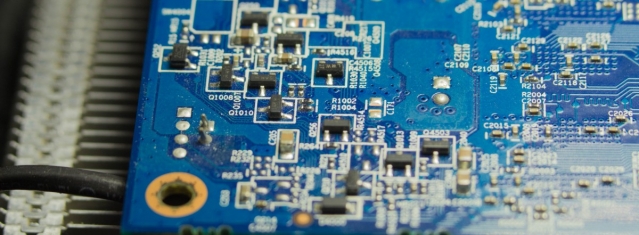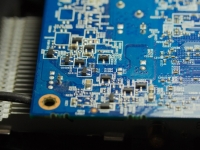Technology
Challenges to Taiwanese Microelectronic Industry
Taiwanese Microelectronic Industry

Microchip (Source: https://pxhere.com/en/photo/1053377)
USPA NEWS -
Despite being the driving force behind the economic development of the country, the Taiwan microelectronics industry is facing some serious problems that threaten to derail the number one position among the global microelectronic industry.
One of the challenges that the industry faces is the shortage of electricity. Power shortage is a long standing problem for Taiwan and the microelectronic industry is facing the brunt. Recently, Taiwan Semiconductor Manufacturing Co. (TSMC), the world´s largest chip foundry, urged the Taiwan government to solve the power supply issue claiming that it could impact TSMC as soon as five years from now.
This problem however does not seem to be getting solved very soon as Taiwan Power Co., Taiwan´s government-run power monopoly announced possible rationing of electricity during peak demand periods in the summer. Companies that consume more than 1000 Kw of electricity every day would be informed a day earlier about the next days´ restrictions. This problem can cripple production in the microelectronic units.
This problem however does not seem to be getting solved very soon as Taiwan Power Co., Taiwan´s government-run power monopoly announced possible rationing of electricity during peak demand periods in the summer. Companies that consume more than 1000 Kw of electricity every day would be informed a day earlier about the next days´ restrictions. This problem can cripple production in the microelectronic units.
While power problems plague the microelectronics industry in Taiwan, the industry faces an outside challenge. The Chinese advancement in the segment is threatening to take away business from the Taiwanese manufacturers.
“China is posing a bigger threat on Taiwan´s IC (integrated circuits) design, especially after the large fund has set in. But Taiwan´s IC design houses are starting to diversify risks or increase their relations with local governments in China,“ said Annie Shih, Market Intelligence & Consulting Institute Senior Industry Analyst.
In order to boost homegrown chip production and cut its reliance on imports, Chinese government set up a fund of almost US$20 billion in 2014. Industry experts anticipate that this move would help propel China ahead of Taiwan in microelectronic manufacture output by 2016. China´s free trade agreement with Taiwan´s biggest export rival South Korea is also expected to present problems to the Taiwan microelectronic industry.
However in the wafer foundry sector that Taiwan still holds the leadership position.
“China is posing a bigger threat on Taiwan´s IC (integrated circuits) design, especially after the large fund has set in. But Taiwan´s IC design houses are starting to diversify risks or increase their relations with local governments in China,“ said Annie Shih, Market Intelligence & Consulting Institute Senior Industry Analyst.
In order to boost homegrown chip production and cut its reliance on imports, Chinese government set up a fund of almost US$20 billion in 2014. Industry experts anticipate that this move would help propel China ahead of Taiwan in microelectronic manufacture output by 2016. China´s free trade agreement with Taiwan´s biggest export rival South Korea is also expected to present problems to the Taiwan microelectronic industry.
However in the wafer foundry sector that Taiwan still holds the leadership position.
“Wafer foundry is actually a high-end service industry rather than manufacturing industry. It requires a lot of high quality labor to build the industry and we´re not certain if China can catch up that quickly,“ said Masson Li, the vice president of Taishi Holdings Research Department.
The biggest challenge for the microelectronics industry in Taiwan, however, emanates from within the country. Acute shortage of water and tough environment regulations with regards to water pollution from microelectronic industry is a constant challenge that companies have to deal with every day.
To manage the water shortage, the government has announced a four stage program where the water supply would be regulated for industries and households.
Pollution of water in the country exacerbates the challenge for the microelectronics industry.
“We have 90,000 legal factories, thousands of illegal ones, and hundreds of landfills located near rivers, but only 4% of Taiwan´s territory is served by sewage systems,“ says Du Yu, chief executive officer of the Chen-Li Task Force for Agricultural Reform, a group of university professors promoting sustainable farming.
The biggest challenge for the microelectronics industry in Taiwan, however, emanates from within the country. Acute shortage of water and tough environment regulations with regards to water pollution from microelectronic industry is a constant challenge that companies have to deal with every day.
To manage the water shortage, the government has announced a four stage program where the water supply would be regulated for industries and households.
Pollution of water in the country exacerbates the challenge for the microelectronics industry.
“We have 90,000 legal factories, thousands of illegal ones, and hundreds of landfills located near rivers, but only 4% of Taiwan´s territory is served by sewage systems,“ says Du Yu, chief executive officer of the Chen-Li Task Force for Agricultural Reform, a group of university professors promoting sustainable farming.
While water used for irrigation soaks into the ground, water diverted to industrial or urban use is eventually discharged into the ocean, causing the ground water level to drop in the long run.
The threat of water pollution by illegal industries is being borne by the microelectronics segment. Sections of the industry are of the view that microelectronics industries need to make arrangements of their own to boost the reuse and recycling of the discharged water. This, of course, demands adequate and efficient water treatment facilities.
There is also talk about increasing the tap water prices in Taiwan so that industries are forced to set up waste water treatment plants.
The Microelectronics industry is abuzz with modern technologies that are cost effective and yet efficient. Modern and state of the art technologies are gaining popularity among the microelectronics industry.
The threat of water pollution by illegal industries is being borne by the microelectronics segment. Sections of the industry are of the view that microelectronics industries need to make arrangements of their own to boost the reuse and recycling of the discharged water. This, of course, demands adequate and efficient water treatment facilities.
There is also talk about increasing the tap water prices in Taiwan so that industries are forced to set up waste water treatment plants.
The Microelectronics industry is abuzz with modern technologies that are cost effective and yet efficient. Modern and state of the art technologies are gaining popularity among the microelectronics industry.
The new regulations that are planned to be imposed by the EPA Taiwan would be stricter and would require better and state of the art wastewater treatment technologies. The reduction of NH4 ““ N discharge is one such issue that the semiconductor industry would have to address in order to adhere to the strict environment regulations. The systems to be put in place need to be flexible and robust as well as cost effective.
Environmentalists suggest technologies like the rapid filtration process and the biological nitrogen removal process with the addition of a coagulant are answers to this problem of the industry.
However there is some degree of reluctance among the manufacturers to adopt advanced waste water treatment technologies.
Companies in the semiconductor, LCD panel and printed circuit board sectors are also concerned about the drastic decline in rainfall and subsequent potentially stringent water restrictions in Taiwan that would be calamitous for production. Many are now trying to solve the challenge through effective water recycling and advanced technologies.
Environmentalists suggest technologies like the rapid filtration process and the biological nitrogen removal process with the addition of a coagulant are answers to this problem of the industry.
However there is some degree of reluctance among the manufacturers to adopt advanced waste water treatment technologies.
Companies in the semiconductor, LCD panel and printed circuit board sectors are also concerned about the drastic decline in rainfall and subsequent potentially stringent water restrictions in Taiwan that would be calamitous for production. Many are now trying to solve the challenge through effective water recycling and advanced technologies.
The necessity to adopt new waste water treatment technologies has been accentuated by recent enhanced sanctions imposed by the Taiwan government. The maximum fine imposable has now been fixed at NT$20 million for industries and firms that do not comply with the latest regulations.
Given the present external threats from China and the internal business problems like power shortage ““ both of which require governmental intervention, the problem of water shortage can be effectively managed by efficient waste water recycling and reuse and thus reduce dependency on government water resources and the associated threat from water rationing.
Given the present external threats from China and the internal business problems like power shortage ““ both of which require governmental intervention, the problem of water shortage can be effectively managed by efficient waste water recycling and reuse and thus reduce dependency on government water resources and the associated threat from water rationing.
Liability for this article lies with the author, who also holds the copyright. Editorial content from USPA may be quoted on other websites as long as the quote comprises no more than 5% of the entire text, is marked as such and the source is named (via hyperlink).






